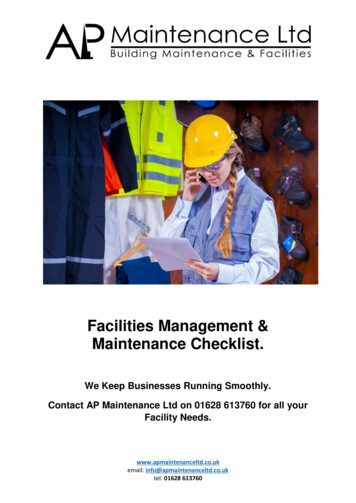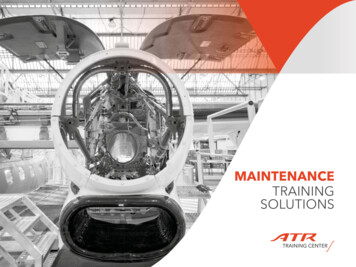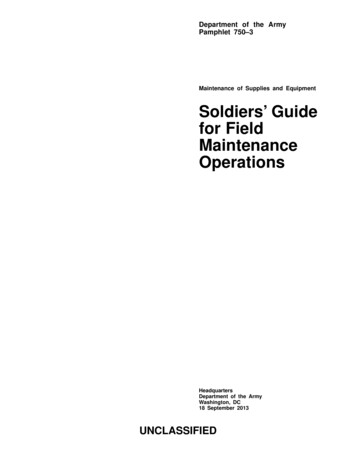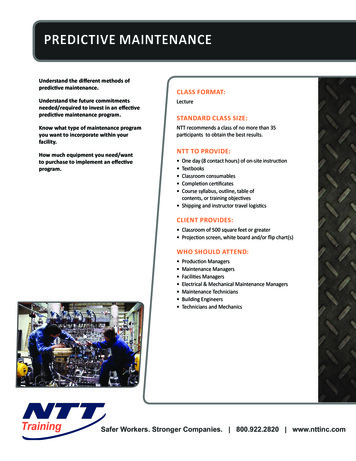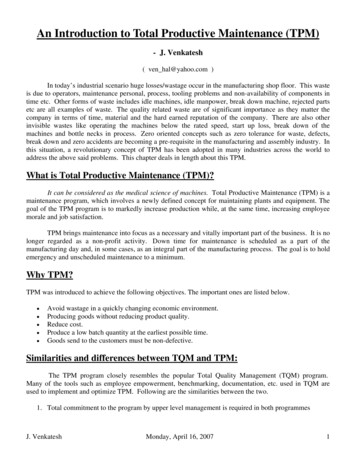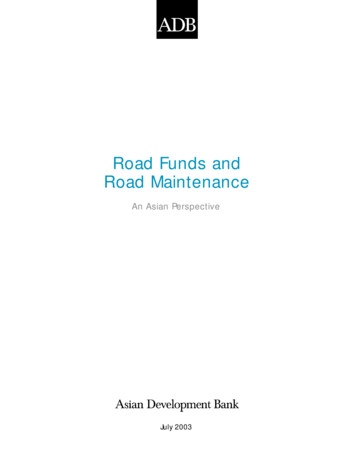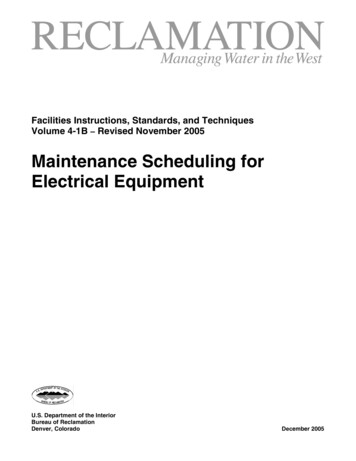
Transcription
HeatingVentilation LEPRACTICESSYSTEMSGuide to Best Practice Maintenance& Operation of HVAC Systems forEnergy EfficiencyJanuary 2012Council of Australian Governments (COAG)National Strategy on Energy Efficiency
This document was written by Lasath Lecamwasam, John Wilson and David Chokolich (GHD)Published by the Department of Climate Change and Energy Efficiency.http://climatechange.gov.au/ISBN: 978-1-922003-15-7 (print version), 978-1-922003-16-4 (pdf version). Commonwealth of Australia 2012.This work is copyright Commonwealth of Australia. All material contained in this work is copyright the Commonwealth of Australia.Commonwealth copyright material is licensed under the Creative Commons Attribution 3.0 Australia Licence.To view a copy of this licence, visit http://creativecomons.org/licenses/by/3.0/au/.You are free to copy, communicate and adapt the Commonwealth copyright material, so long as you attribute theCommonwealth of Australia (Department of Climate Change and Energy Efficiency) and the authors in the following manner:Guide to Best Practice & Maintenance & Operation of HVAC Systems for Energy Efficiency by Lasath Lecamwasam, John Wilson andDavid Chokolich (GHD). Commonwealth of Australia 2012.DisclaimerCommonwealth of AustraliaThis document is produced for general information only and does not represent a statement of the policy of theCommonwealth of Australia. While reasonable efforts have been made to ensure the accuracy, completeness and reliabilityof the material contained in this document, the Commonwealth of Australia and all persons acting for the Commonwealthpreparing this report accept no liability for the accuracy of or inferences from the material contained in this publication, or for anyaction as a result of any person’s or group’s interpretations, deductions, conclusions or actions in relying on this material.AcknowledgementsAs part of the National Strategy on Energy Efficiency the preparation of this document was overseen by theCommercial Buildings Committee, comprising officials of the Department of Climate Change and Energy Efficiency,Department of Resources Energy and Tourism and all State and Territory Governments.The Committee wishes to thank representatives from the HVAC sector and associated industry bodies for theirtime and professionalism in providing assistance in the preparation of this document, including:Andrew AitkenGreen Building Council of AustraliaBryon PriceFacilities Management Association of AustraliaChris WallbankJones Lang LaSalleFrank ParrelloDepartment for Transport Energy and Infrastructure (SA)Glen TatamACMV Design ConsultantsJane MacnamaraProperty Council of AustraliaJohn PirovichColliers InternationalLloyd WoodfordDepartment of Climate Change and Energy EfficiencyPeter KinsellaChartered Institution of Building Services EngineersPhil WilkinsonAustralian Institute of Refrigeration, Air Conditioning and HeatingProject Background – Heating, Ventilation & Air Conditioning – High Efficiency Systems Strategy (HVAC HESS)The HVAC HESS, a ten-year strategy under NFEE, focuses on energy efficiency improvements in theinstallation, operation and maintenance of HVAC systems in commercial buildings.The current three-year work program under the Strategy known as the Cool Efficiency Program commenced in 2009–10 FY.The Strategy is designed to achieve long term improvements in the energy efficiency of HVAC systems, particularlyin commercial building applications. The Strategy is aimed at whole of life improvements in HVAC efficiency,encompassing design, manufacture, installation, operation and maintenance. A large part of the gains targeted arein the maintenance and operation of existing systems in existing buildings, and through the establishment of nationalstandard systems of documentation of the design, installation, operation and maintenance of the equipment.The Strategy has been designed to address many non technical barriers to efficiency, while identifyingand promoting highly efficient technical solutions, systems optimisation processes, and creating theenvironment in which energy efficiency gains are valued, measurable and sustainable.With more than 20 separate but complementary measures, the Strategy is aimed at threebroad areas of HVAC improvements: Practices; Systems; and People.This project, funded under the Cool Efficiency Program, is part of the National Strategy on Energy Efficiency, agreed by COAG on 2 July 2009.Further /nfee/committees/hvac/default.html
Guide to Best PracticeMaintenance & Operationof HVAC Systems forEnergy EfficiencyJanuary 2012
GLOSSARYAHUAir Handling UnitAIRAHAustralian Institute of Refrigeration, Air Conditioning and HeatingAMCAAir Conditioning and Mechanical Contractors’ Association of AustraliaARCAustralian Refrigeration CouncilASAustralian Standard (AS/NZS – Australian New Zealand Standard)ASHRAEAmerican Society of Heating, Refrigerating and AirXConditioning EngineersBACnetA type of communications protocol (language) used by BMSBASBuilding Automation System (also refer to BMS)BCABuilding Code of Australia (since 2011 referred to as the National Construction Code-NCC).BEMSBuilding Energy and Monitoring System (BMCS – Building Monitoring and Control System)BIMBuilding Information Modeling (BIMM – Building Information Modeling and Management)BMSBuilding Management System (also refer to BEMS and BAS)BOMBureau of MeteorologyCADComputer Aided DesignCBDCommercial Building DisclosureCFCChloro Fluoro Carbon (a refrigerant that is banned under the Montreal Protocol)CIBSEChartered Institution of Building Services EngineersCMMSComputerised Maintenance Management SystemsCOPCoefficient of Performance (a measure of efficiency of a chiller, also refer to IPLV)DCCEEDepartment of Climate Change and Energy EfficiencyDEWHADepartment of the Environment, Water Heritage and the ArtsEEGOEnergy Efficiency in Government OperationsEEREnergy Efficiency RatioEIREnvironmental Impact Rating (a factor that takes into account the environmental impactof HVAC equipment in a building)FMAFacilities Management Association of AustraliaGBCAGreen Building Council of AustraliaGWPGlobal Warming PotentialHCFCHydro Chloro Fluoro Carbon (a generic type of Refrigerant)HVACHeating, Ventilation and Air ConditioningHVCAHeating and Ventilating Contractors’ Association (United Kingdom)iiGuide to Best Practice Maintenance & Operation of HVAC Systems for Energy Efficiency
ICAIndependent Commissioning AgentIAQIndoor Air QualityIEQIndoor Environment Quality (covers IAQ, thermal comfort, noise and lighting)IPLVIntegrated Part Load Value (a measure of efficiency of a chiller)IRRInternal Rate of ReturnKg CO2-eKilogram carbon dioxide equivalent (used in greenhouse gas coefficient)KPIKey Performance IndicatorkWhKilowatt Hour, unit of energy equal to 1,000 watt hours, typically used for electricityLCALife Cycle AnalysisLCCLife Cycle CostsMJMega Joule, unit of energy equal to a million joules, typically used for gasMLMega Litre, a million litresMEPSMinimum Energy Performance StandardsNABERSNational Australian Built Environment Rating SystemNCCNational Construction Code (also refer to BCA)NGERSNational Greenhouse and Energy Reporting SystemNLANet Lettable Area (measured in accordance with the PCA Method of Measurement)NPVNet Present ValueODPOzone Depletion PotentialPCAProperty Council of AustraliaPPMPlanned Preventative MaintenanceQAQuality AssuranceTDCTotal Dissolved SolidsTLPTenants Lighting and PowerVAVVariable Air VolumeVSDVariable Speed Drive (also known as Variable Frequency Drive)Glossaryiii
CONTENTS1.INTRODUCTION TO THIS GUIDE11.1About this Guide11.2Why consider efficiency in HVAC Systems?21.3Who Would Benefit from This Guide?41.4How to use this Guide?61.5Stakeholder Responsibilities72.HVAC MAINTENANCE IMPLEMENTATION PROCESS112.1General Information122.2Develop Policies & Obtain Corporate Support122.3Develop Strategies & Allocate Resources132.4Prepare Documentation152.5Maintenance Management, Monitoring & Training193.BUILDING OPERATION233.1Building Owner233.2Facilities Manager243.3Occupants & Tenants253.4Maintenance Service g & Maintenance Manuals274.3Maintenance Log Books284.4Building User Guides284.5Tenancy Fit-out Guidelines294.6Asset Register304.7Environmental Impact Rating (EIR)31ivGuide to Best Practice Maintenance & Operation of HVAC Systems for Energy Efficiency
5.FINANCIAL & ENVIRONMENTAL EVALUATION325.1Introduction325.2Simple Payback Period325.3Net Present Value325.4Internal Rate of Return335.5Life Cycle Analysis335.6Benefits of Economic Analysis335.7Environmental Evaluation346.HVAC EQUIPMENT & ng Towers426.4Air Handling Units & VAV ation & De-Humidification526.9Packaged HVAC Systems546.10Power Factor Correction556.11Building Management Systems566.12Commissioning & Building Tuning586.13Trends in HVAC Design over the past 20 Years59APPENDICESAppendix A: Definitions of Key Words61Appendix B:69Checklist – Building OwnerAppendix C: Checklist – Facilities Manager70Appendix D: Checklist – Building Occupant/Tenant73Appendix E:Checklist – Maintenance Service Provider74Appendix F:Checklist – Energy and Maintenance Auditor81Appendix G: Checklist – Controls Specialist82Appendix H: Checklist – Design Engineer84Contentsv
LIST OF FIGURES AND TABLESTABLE INDEXTable 4.1:Information in Asset Register30Table 5.1:Emission Factors35FIGURE INDEXFigure 1.1:Benefits from Best Practice Maintenance & Operation3Figure 1.2:Benefits to Stakeholders from this Guide5Figure 1.3:Document Structure7Figure 1.4:Typical Team Structure9Figure 2.1:Steps to Maintenance Implementation11Figure 2.2:HVAC Systems and Key Activities22Figure 5.1:Life Cycle Cost Vs. Efficiency34Figure 6.1:Typical Energy Consumption Breakdown in an Office Building36Figure 6.2:Typical Energy Consumption Breakdown in a HVAC System37viGuide to Best Practice Maintenance & Operation of HVAC Systems for Energy Efficiency
1. Introduction to this Guide1.1About this GuideIt is hoped that this Guide to Best PracticeMaintenance & Operation of HVAC Systems forEnergy Efficiency will be a change accelerator andencourage those working with maintenance &operation of HVAC Systems to have a sharper focuson improving energy and water efficiency.The advice in this Guide is relevant to typical HeatingVentilation and Air Conditioning (HVAC) Systems thatare installed in commercial office type buildings. It isapplicable to existing buildings – both old and new,small to large and different grades from premiumgrade city CBD to rural. The advice given in thisGuide may also be applicable to buildings otherthan commercial office type buildings. The Guideis also applicable to future buildings that are beingdesigned – it addresses important topics to considerduring the design and documentation stages of newprojects.This Guide identifies and recognises the importanceof existing Australian and International standardsand guidelines for maintenance of HVAC Systemsand attempts to avoid the repetition of materialalready published. Existing publications cover factorsfor consideration when setting up maintenancecontracts including statutory requirements foroccupational health and safety, maintenanceschedules for reliability, occupant comfort andcontract administration. For the maintenanceof HVAC Systems in Australia, the availability ofthe AIRAH application manual DA19 – HVAC&RMaintenance is acknowledged. This Guidefocuses on energy and water efficiency aspectsof maintenance and operation, complementingthe advice and maintenance schedules alreadypublished in DA19.WHAT THE GUIDE COVERS:This guide provides information on the following: Getting best results from existingmaintenance contracts to increase energyand water efficiencies from HVAC Systems.Many of the recommendations in this Guide will1. Introduction to this Guidegive cost effective benefits to Building Owners,Facilities Managers and Maintenance ServiceProviders operating within existing maintenancecontracts Improving the energy and waterperformance ratings (NABERS energy andwater) of existing buildings Maintaining the performance andefficiencies of buildings that are currentlydelivering target ratings and require regularmonitoring, fine-tuning and re-balancingof the HVAC Systems. Buildings are becomingincreasingly complex, analogous with aeroplanesrequiring ‘fly by wire’ technology in order tokeep flying. An example is failure of humiditycontrol in buildings that have chilled beams forair conditioning and the occupants ‘getting wet’.This Guide highlights the value of continuousmonitoring and ongoing building tuning towardsmaintaining high performance and efficiency Technical issues that affect sustainability whichare relevant to Maintenance Technicians andControls and Commissioning Specialists Important topics which are relevantto energy and water efficiencies, forconsideration when writing specificationsfor future HVAC maintenance contracts Key issues which Design Engineers and Controlsand Commissioning Specialists must considerwhen designing and working on projects fornew buildings Potential energy and water savingopportunities to consider when maintainingor upgrading HVAC equipment. This Guidepromotes teamwork and collaboration betweenMaintenance Service Providers, FacilitiesManagers and Building Owners to proactivelyidentify opportunities for saving energy and water Setting up monitoring systems andkey performance indicators (KPIs) to enablebenchmarking of the energy and waterperformance of buildings and to verify the1
effectiveness of measures put in place to improveenergy and water efficiency Information on the assessment of potentialFinancial and Environmental benefits gainedthrough replacement and upgrade options forHVAC equipment.WHAT THE
Appendix C: Checklist – Facilities Manager 70 Appendix D: Checklist – Building Occupant/Tenant 73 Appendix E: Checklist – Maintenance Service Provider 74 Appendix F: Checklist – Energy and Maintenance Auditor 81 Appendix G: Checklist – Controls Specialist 82 Appendix H: Checklist – Design Engineer 84


